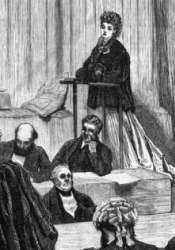The Married Women's Property Act of 1870
The Married Women’s Property Act of 1870 was the first of many similar acts that would soon come within the following decade. It laid out the basic desires of how a married woman wanted her own property to be handled and when it was enabled, it triggered the death of coverture. This was a legal doctrine that claimed two people would become one under the law once they got married (Ablow). Coverture erased a woman’s legal rights and individuality making her sole purpose servitude to her husband, which is why this act was, and still remains, so significant to the women’s rights movement in the late 19th century. The Married Women’s Property Act of 1870 was a milestone for women’s emancipation (Combs).
The push for married women’s property rights began in the 1860’s with the Kensington Society and the Manchester Women’s Suffrage Society, both of which were groups of women who worked to advance women’s education, social, and economic rights (Shanley 49). More specifically, it was Elizabeth Wolstenholme, Jessie Boucherett, Elizabeth Gloyne, and Josephine Butler who assembled the first workings of a campaign in support of passing a married women’s property bill (Shanley 52). They contacted a radical Manchester lawyer, Dr. Richard Pankhurst, to draft the bill and in April 1868 the Married Women’s Property Bill was brought forth to the House of Commons by George Shaw Lefevre and co-sponsored by John Stuart Mill and Russell Gurney (Shanley 53, Holcombe 166). Despite their attempt to pass the Bill, the House of Commons was too conservative and not open to this idea of allowing women to have control over their own property. To the House, this would have been too radical a change. One commenter proclaimed that “the pompous platitudes about authority [of men] and subordination [of women], savoring strongly of the henpecked husband” (Holcombe 166). For the reader’s clarification, a “henpecked husband” is a man who is intimidated, bullied, or dominated by a woman ("Henpecked Husband."), and it is not the highest compliment a man can receive in the 19th century England. Instead of passing this Bill, the House of Commons extended the protection-order system initiated by Divorce Act of 1857 which allowed married couples to divorce their significant other under the court of law, provided that there were distinct, special circumstances (Holcombe 166).
While some may have thought that this would deter the women’s suffrage movement that was growing in England at the time, the rejection of the Women’s Property Act Bill only fanned the flames higher. The Bill was brought back to the House of Commons in 1869 with the hopes of it passing this time around. It seemed as though some luck was brought to the supporters of the Bill at the time because at the end of 1868 there was a general election the lead to a liberal take over in the House of Commons and brushed the majority of conservatives out of office (Holcombe 168). Witnesses were gathered in order to speak on the injustice done to themselves and women by the lack of a law that genuinely protected women’s property. The protection-order system that was enabled by the Divorce Act of 1857 had proven to be completely ineffective in protecting a woman’s rights, thus the need for a well laid out property law (Holcombe 168). This second debate had moved on from the old arguments brought up in the first and tried to focus on new reasoning for passing or not passing the bill. No one argued that it was the Divine Right of a husband to take his wife’s property, or that this bill would weaken the authority of the Church if passed (Holcombe 169).
Due to the liberal majority in the House of Commons, the Bill was passed on to the Lords and eventually was passed on August 9th, officially becoming the Married Women’s Property Act of 1870 (Combs). It gave women married after 1870 the right to earn and keep their own wages separate from their husband, invest in stocks, take money out of the bank, and is entitled to any property or money left to her by her parents or family (“CHAP. 93 An Act to amend the Law relating to the Property of Married Women.”). While there would be more Married Women’s Property Acts like this to follow, the one that was passed in 1870 made it known to all that women deserve the right to own their own property just as much as men do.
Works Cited:
Ablow, Rachel. “One Flesh, One Person, and the 1870 Married Women's Property Act.” BRANCH, Britain Representation and Nineteenth-Century History, 2007, https://www.branchcollective.org/?ps_articles=rachel-ablow-one-flesh-one... the-1870-married-womens-property-act.
“CHAP. 93 An Act to amend the Law relating to the Property of Married Women.” The Public General Statutes, The Queen's Printing Office, 1871, pp. 577–581.
Combs, Mary Beth. “‘A Measure of Legal Independence’: The 1870 Married Women's Property Act and the Portfolio Allocations of British Wives: The Journal of Economic History.” Cambridge Core, Cambridge University Press, 22 Nov. 2005, www.cambridge.org/core
"Henpecked Husband." Farlex Dictionary of Idioms. 2015. Farlex, Inc 1 Oct. 2020 https://idioms.thefreedictionary.com/henpecked+husband
Holcombe, Lee. Wives & Property : Reform of the Married Women's Property Law in Nineteenth-Century England. University of Toronto Press, 1982.
Shanley, Mary Lyndon. Feminism, Marriage, and the Law in Victorian England, Princeton University Press, 1993, pp. 49–78.

